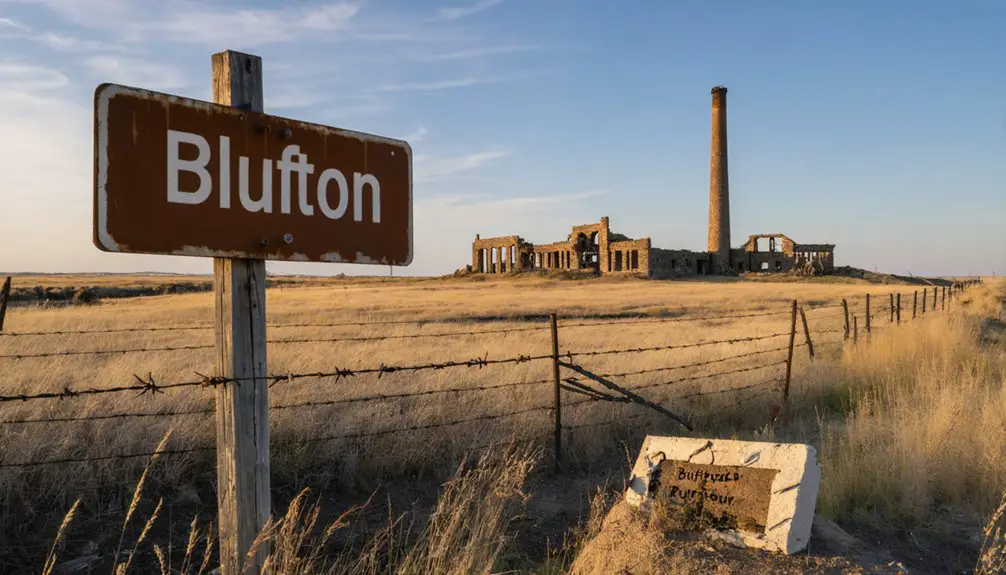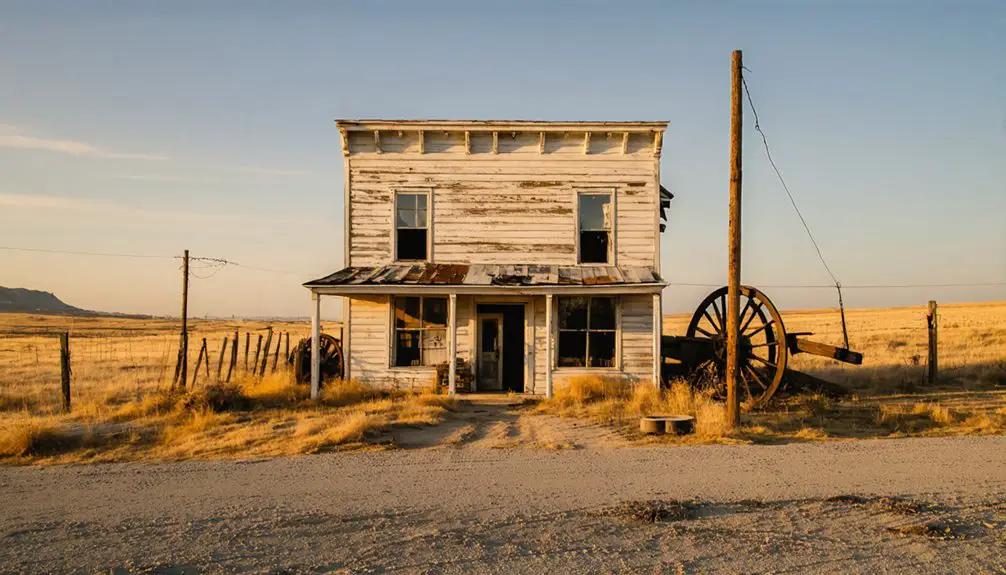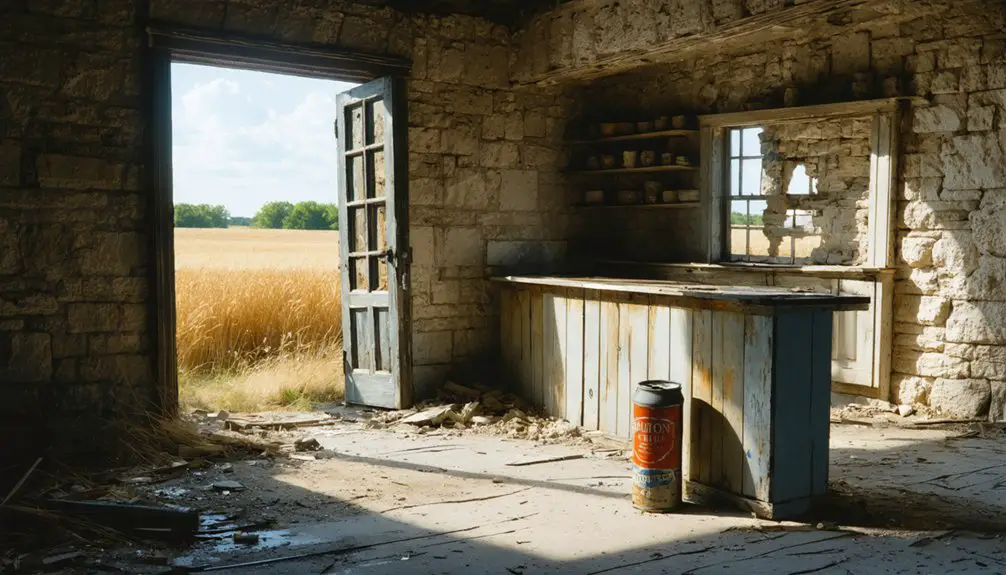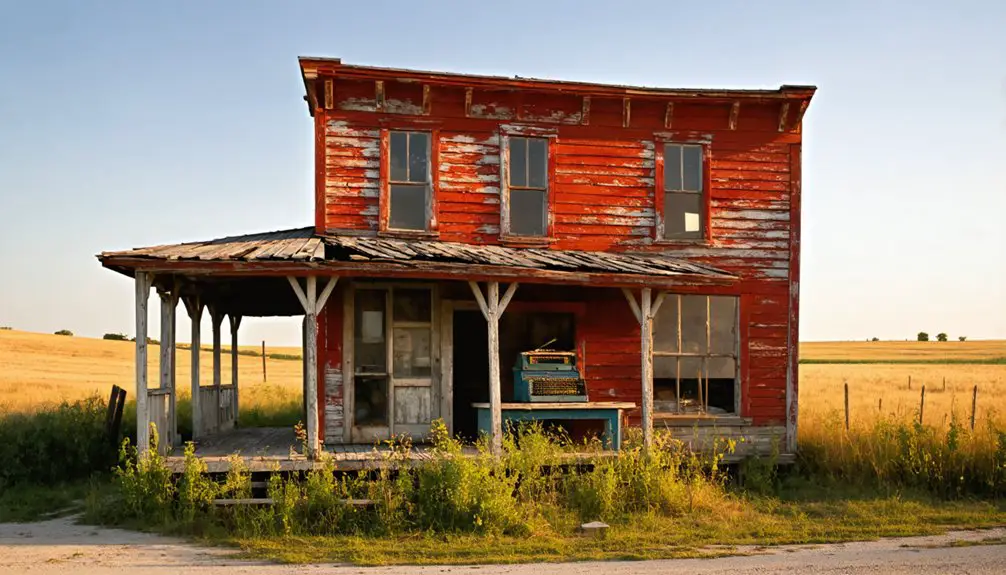You’ll find Blufton Station‘s ruins in Trego County, Kansas, where it once served as an essential waypoint along the historic Smoky Hill Trail. The station thrived near cedar-covered bluffs and a magnesia spring until 1867, when repeated raids by Cheyenne warriors forced its abandonment. Today, only sandstone formations mark where travelers once carved symbols into bluff walls, telling stories of frontier life, dangerous passage, and ultimately failed settlement along this treacherous trail.
Key Takeaways
- Blufton was a vital station along the Smoky Hill Trail in Trego County, Kansas, serving as a rest stop and freight depot.
- The station was strategically located near cedar-covered bluffs and a magnesia spring before becoming a ghost town in 1867.
- Native American raids, particularly by Cheyenne Dog Soldiers, led to the station’s destruction and eventual abandonment during 1867-1869.
- Today, only sandstone formations and challenging terrain remain where the once-active frontier station stood.
- The site’s abandonment reflected broader changes in frontier settlement patterns following the arrival of the Kansas Pacific Railway in 1870.
The Rise of a Frontier Outpost
While many frontier outposts dotted the Kansas plains during America’s westward expansion, Blufton emerged as an essential station along the Smoky Hill Trail in Trego County.
As settlers pushed west across Kansas, Blufton stood as a vital waypoint on the Smoky Hill Trail’s long journey through Trego County.
You’ll find this strategic outpost positioned near distinctive cedar-covered bluffs and a magnesia-rich spring, making it an ideal frontier logistics hub for the Butterfield Overland Despatch and other stagecoach operations.
The settlement strategies behind Blufton’s location proved shrewd. Opposite a commanding river bluff that travelers described as a “vast castle,” the station served multiple purposes.
It provided a significant rest stop for settlers heading west, supported crucial mail and freight operations, and offered a defensive position during a time of increasing tensions. Early travelers carved their names and symbols into the bluff walls, including Masonic square and compass emblems that marked their passage.
The station’s placement within the broader network of frontier facilities helped protect the expanding flow of commerce and migration westward. The trading post’s operations came under scrutiny when Butterfield sold arms to Native Americans under the pretense of peaceful trade.
Life Along the Smoky Hill Trail
If you’d traveled the Smoky Hill Trail in the 1860s, you’d have faced constant threats from hostile Plains Indians who viewed the stagecoaches as invaders of their traditional hunting grounds.
Fort Wallace and other military outposts provided crucial protection for travelers along the dangerous route.
Your journey would’ve been marked by brutal weather conditions and scarce water sources, with relay stations offering only brief respite every twelve miles along the dangerous route.
Despite these challenges, you’d have joined countless other pioneers seeking fortune and new beginnings, though many settlers met tragic ends through starvation, exposure, or violent confrontations.
The arrival of the Kansas Pacific Railway in 1870 finally brought safer and more reliable transportation through these perilous territories.
Dangerous Stagecoach Travel
Although stagecoach travel along the Smoky Hill Trail promised adventure and opportunity, passengers faced constant dangers during their 592-mile journey between Atchison, Kansas, and Denver, Colorado.
You’d encounter unpredictable weather, exposed plains, and the ever-present threat of Native American attacks while defending their lands. Despite military protection from forts like Fort Downer and Fort Wallace, the vast distances between stations left you vulnerable. The Ben Holladay stage line took control of operations in 1866, but the dangers persisted. Relay stations were built every 12 miles to provide brief respites from the perilous journey.
Your survival on the trail depended on:
- Staying alert during the 12-mile stretches between relay stations
- Following military escort protocols when available
- Being prepared for sudden attacks, especially in remote areas
The stagecoach dangers were so severe that even experienced drivers couldn’t guarantee your safety, as attack strategies by Native Americans often targeted the most vulnerable sections of the route.
Frontier Settlement Challenges
Since settling along the Smoky Hill Trail promised both opportunity and hardship, you’d face intimidating challenges that tested human endurance at every turn. Your daily survival would depend on maneuvering resource scarcity in a harsh landscape, where limited water sources and extreme weather conditions could spell disaster. Reports in local newspapers warned of severe suffering and starvation among travelers.
You’d contend with wild buffalo herds damaging trail markers while staying vigilant against Plains Indian raids. Emigrant wagons carried crucial provisions as they made the difficult journey west.
Settlement hardships went beyond natural obstacles. The desolate “Starvation Trail” sections lived up to their name, forcing you to carefully ration supplies. Your shelter options would be minimal, leaving you exposed to the elements.
While military forts offered some protection, you’d still need to be self-reliant. Despite these challenges, the promise of gold, farmland, or ranch opportunities drove settlers to persevere, gradually transforming the frontier landscape.
Natural Landmarks and Geography
Located near the southeastern edges of Kansas Hill Country, Blufton’s terrain features the gently rolling prairie hills and mixed-grass plains characteristic of the region’s shifting ecosystem.
You’ll find scattered woodlands and limestone outcrops across the landscape, while nearby creeks provided natural irrigation for early settlers. Geographic barriers like rock formations and hills influenced transport routes and railroad placement, ultimately affecting the town’s fate. Like many towns that were built around railroads, Bluffton’s development was shaped by its proximity to transport infrastructure. Natural disasters like flooding and tornadoes likely contributed to the town’s eventual decline.
Key features that shaped Bluffton’s development:
- Elevation ranging from 1,200 to 1,400 feet created natural drainage patterns essential for farming.
- Local limestone and shale formations provided important building materials for pioneer structures.
- Seasonal streams and creek systems enabled small-scale water supply but weren’t substantial enough for major development.
The moderately fertile soils derived from loess deposits supported mixed agriculture, though periodic droughts challenged the town’s sustainability.
Daily Challenges at Bluffton Station
Operating a remote outpost like Bluffton Station brought daily challenges that tested the resilience of its staff and travelers.
You’d face constant logistical issues, from coordinating unpredictable stagecoach schedules to maintaining a reliable water supply that was rich in magnesia. The station’s isolation made it difficult to secure basic provisions and necessary repairs.
Economic struggles plagued the station’s operations, as revenue depended heavily on fluctuating traveler traffic. You’d need to manage limited resources while competing with better-positioned stations.
The harsh environment didn’t help – you’d battle extreme weather, wildlife threats, and maintaining sanitation standards. Communication barriers and outdated facilities further complicated daily operations, while the constant need for livestock care and infrastructure maintenance stretched the station’s minimal staff to their limits.
Conflicts and Native American Relations

You’d find the Bluffton Station particularly vulnerable to nighttime raids by Native American warriors, who used the surrounding terrain’s natural features like Beaver Creek and Hundred Head Draw as strategic ambush points.
The increasing frequency of these attacks, especially from Cheyenne bands including the Dog Soldiers, made defending the remote outpost nearly impossible.
After suffering repeated strikes and destruction of property, settlers ultimately abandoned the station, which was later burned to the ground during the violent period of 1867-1869.
Raiders Strike at Night
During the tumultuous period of 1867-1869, Native American raiders launched devastating nighttime attacks along Kansas’s Smoky Hill, Saline, and Solomon Rivers, targeting vulnerable settlers and disrupting frontier life in Bluffton.
Using stealth tactics, warriors exploited the region’s rugged terrain of rocky gullies, bluffs, and wooded areas to conceal their movements before striking. Night ambushes proved particularly lethal at locations like Threshing Machine Canyon, where raiders killed unsuspecting freighters at their campfires.
Three key aspects of these raids:
- Warriors carefully selected attack points near river bluffs and canyons to maximize surprise.
- Raids deliberately targeted isolated camps and stations with minimal defenses.
- Night attacks effectively disrupted crucial supply lines and communication routes essential to frontier settlements.
Violence Forces Station Abandonment
The escalating violence of Native American raids near Bluffton Station reached a breaking point in 1867, forcing its complete abandonment and eventual destruction.
You’d have witnessed increasing settler fears as Native warriors targeted vulnerable homesteads and stations along the Smoky Hill Trail, killing travelers and destroying essential infrastructure.
Military responses couldn’t prevent the station’s demise. Even after Bluffton’s abandonment, the dangers persisted – raiders concealed in nearby gullies would ambush unsuspecting freighters who still used the area for camping.
The location earned its ominous nickname “Threshing Machine Canyon” from these deadly encounters. The loss of this strategic rest and resupply point disrupted travel patterns and commerce, demonstrating how Native resistance effectively challenged American expansion across the Kansas frontier.
Hidden Ambush Points Identified
Strategic positioning of ambush points around Bluffton reflected the deep territorial knowledge of Native American tribes like the Kanza, Osage, Pawnee, and Comanche who inhabited the region.
You’ll find these ambush strategies concentrated near waterways and elevated terrain, where dense forests provided natural cover for tribal warfare. The landscape’s tactical advantages shaped both defensive positions and offensive raids.
- River bends and creek mouths offered concealed positions where warriors could monitor approaching threats.
- Elevated bluffs provided commanding views of emigrant trails and supply routes below.
- Dense woodland near water crossings created natural choke points for executing surprise attacks.
As tribes faced increasing pressure from U.S. Indian removal policies, these strategic locations became critical for protecting territories and resisting forced relocation through calculated defensive measures.
The Final Days of Settlement

Violent clashes with Native Americans marked Bluffton’s final chapter as settlers abandoned their homes and businesses in the mid-1860s.
You’ll find that settlement patterns shifted dramatically as survivors sought refuge in more defensible locations like White Rock Canyon. By 1865, you’d have discovered the station burned and deserted, a stark indication to the area’s increasing dangers.
Survivors fled to safer ground like White Rock Canyon as the abandoned station stood as a haunting testament to escalating conflict.
The economic decline accelerated as transportation routes became too dangerous to maintain. You couldn’t safely conduct commerce or freight goods through the region, and the lack of major railroad development sealed Bluffton’s fate.
Even ambitious plans for banks, stores, and residential developments couldn’t overcome the persistent security threats. The 1867 massacre of freighters camped near the bluff served as a final, grim reminder of why settlers chose to leave this once-promising frontier town.
Historical Legacy and Impact
While Bluffton’s physical structures have long since vanished, you’ll find its historical significance deeply woven into Kansas’ frontier narrative. The station’s legacy endures as a representation of the complex economic shifts that shaped the American West, from Native American territories to settler communities.
You can trace Bluffton’s impact through these key developments:
- The alteration of the Smoky Hill Trail from a essential stagecoach route to an abandoned pathway reflects the broader pattern of frontier settlement and retreat.
- The station’s eventual abandonment sparked significant changes in regional transportation routes, forcing adaptations that shaped Kansas’ development.
- The change from station to agricultural settlement illustrates the evolution of Kansas’ economy, as the region moved from transit hub to farming community.
Visiting the Ghost Town Today

Today’s visitors to Blufton will find a stark contrast to its historic past as a bustling station stop. The ghost town exploration reveals only sandstone formations rising like castles from the plains, along with a magnesia-rich spring marking this historically significant site.
You’ll need to prepare thoroughly for your visit, as there aren’t any modern facilities or amenities. The terrain presents challenging deep rocky gullies and bluffs, requiring careful navigation.
Don’t plan on camping near the bluff bases, which remain hazardous. Instead, bring sufficient supplies and plan your trip as a day excursion.
While you won’t find guided tours, the site offers compelling opportunities for photography and geological study. The dramatic landscape and remote setting create an authentic backdrop for experiencing this piece of Kansas frontier history.
Frequently Asked Questions
Were There Any Notable Artifacts Ever Recovered From the Bluffton Station Site?
Like whispers from the past, you’ll find just one significant artifact discovery: charred remnants of a threshing machine that’s now housed in Trego County Historical Museum, preserving Bluffton Station’s historical significance.
What Was the Total Population of Bluffton Station During Its Peak?
You’ll find Bluffton’s peak settlement demographics weren’t precisely recorded, but based on similar Kansas railroad stations and county data, the population likely ranged between 50-300 residents during its busiest period.
Did Any of the Original Station Builders Survive Its Abandonment?
You won’t find definitive survivor testimonies or historical accounts confirming if any original builders survived. While some settlers fled westward, the fate of Blufton Station’s specific builders remains unknown.
What Happened to the Survivors Who Fled Bluffton Station?
Ever wonder what became of those who fled? You’ll find their survivor stories led west to safer settlements, though some locals still whisper of ghost sightings near White Rock Canyon’s cedar-covered bluffs.
How Did the Magnesia-Rich Spring Water Affect the Health of Settlers?
You’d have experienced mixed spring water benefits – potential digestive aid and mineral supplementation, but also possible health impacts like diarrhea and stomach discomfort from the high magnesia content.
References
- https://legendsofkansas.com/bluffton-station/
- https://www.youtube.com/watch?v=A7guEY4xsug
- https://digging-history.com/2014/10/15/ghost-town-wednesday-old-ulysses-kansas/
- http://kansasghosttowns.blogspot.com
- https://www.youtube.com/watch?v=OyBXD18P_j4
- https://www.kancoll.org/khq/1932/32_5_garfield.htm
- https://plainshumanities.unl.edu/encyclopedia/doc/egp.war.017.html
- https://www.youtube.com/watch?v=RTIBnMyh2wk
- https://www.legendsofamerica.com/kansas-trail-history/
- https://www.smokyhilltrail.com



